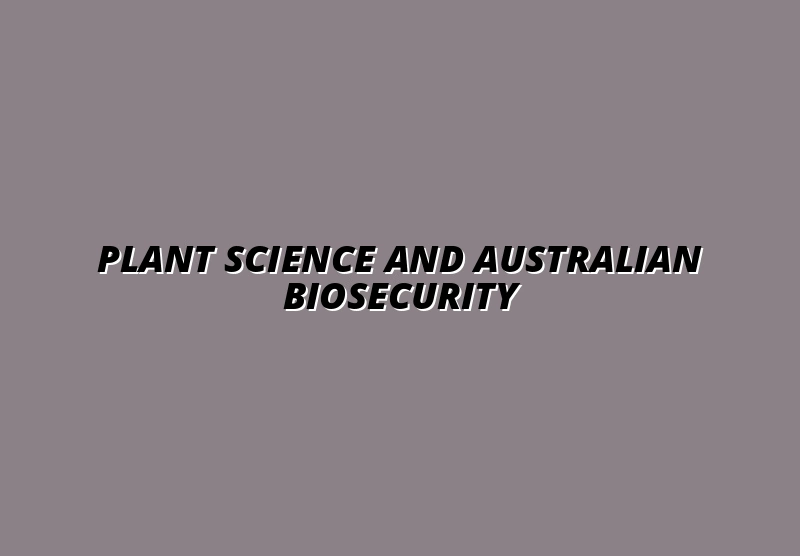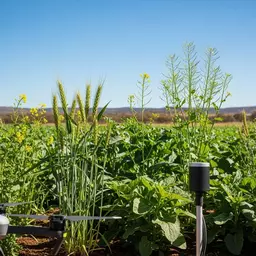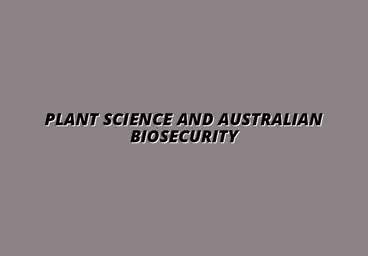Molecular Diagnostics
Rapidly identifies pathogens using genetic markers for early intervention.
As we delve into the intricate world of biosecurity, consider this: the health of Australia’s ecosystems and food systems hinges on our ability to effectively manage threats posed by pests and diseases. With innovative plant science techniques at our disposal, we stand at a critical juncture in safeguarding our agricultural landscape.
This visual illustrates how key plant science techniques align with and enhance critical biosecurity objectives in Australia. For a deeper understanding of the foundational principles, explore understanding biosecurity in Australia.
Rapidly identifies pathogens using genetic markers for early intervention.
Analyzes genetic data to understand pest outbreaks and inform management strategies.
Studies plant diseases to develop resistant varieties and targeted interventions.
Combines biological, cultural, and chemical methods for sustainable pest control.
Australian biosecurity is a critical field dedicated to safeguarding our agriculture, environment, and trade from threats posed by pests and diseases. Biosecurity encompasses a range of practices aimed at preventing the introduction and spread of harmful organisms, ensuring that our food systems remain resilient and our ecosystems thrive. As we face evolving challenges, the significance of robust biosecurity measures cannot be overstated.
At Plant Frontier Insights, we recognize that a well-structured biosecurity framework protects not just our farmers but also our diverse ecosystems. It plays a pivotal role in maintaining the health of our agricultural landscapes while supporting trade relationships that are vital for economic stability.
Defined broadly, Australian biosecurity refers to the policies and practices implemented to protect our nation's biosecurity systems from various threats. These threats can range from invasive species to diseases that can devastate local fauna and flora. By establishing rigorous biosecurity protocols, we can mitigate risks and preserve our unique biodiversity.
The implications of neglecting biosecurity measures can be dire, leading to significant economic losses and environmental degradation. This is why understanding and investing in biosecurity is crucial for Australia's future, and exploring Australia's biosecurity resources can provide further insights.
To combat biosecurity threats effectively, various plant science techniques are emerging as game changers. These methods not only enhance our ability to detect and manage risks but also empower us to act swiftly and decisively.
Molecular diagnostics provides a cutting-edge approach to identifying plant pests and diseases at an early stage. By using genetic markers, scientists can pinpoint the presence of harmful pathogens before they become widespread. This proactive approach allows for timely interventions, which is vital in safeguarding our agricultural assets.
The rapid advancements in molecular diagnostics are transforming how we approach biosecurity, emphasizing the importance of timely information and swift action.
Genomics and bioinformatics are revolutionizing how we assess biosecurity risks. By analyzing genetic data, researchers can better understand the potential for pest outbreaks. This understanding helps in crafting effective management strategies tailored to specific threats.
Integrating bioinformatics tools enhances the efficiency of biosecurity efforts by providing data-driven insights and fostering collaborations that lead to better resource allocation.
Plant pathology plays a fundamental role in diagnosing and managing plant diseases. By studying the symptoms and impact of various plant pathogens, scientists can develop targeted interventions that minimize damage to crops and natural vegetation.
Understanding plant pathology not only helps us react to existing threats but also equips us to anticipate future challenges, ensuring our agricultural systems remain resilient.
The Australian government plays a pivotal role in establishing frameworks that manage biosecurity risks. Through policies and regulations, it creates a safety net that protects our food systems and natural resources.
The Department of Agriculture has implemented a range of policies to enhance our biosecurity measures. These frameworks are designed to address risks associated with both domestic and international biosecurity threats, providing guidance and support to stakeholders in the agricultural sector.
These policies are essential for ensuring that all players in the agricultural landscape understand their responsibilities and are equipped to mitigate risks effectively.
The National Biosecurity Strategy outlines the objectives that guide our efforts in protecting plant health. This comprehensive framework emphasizes collaboration among various sectors, including research organizations, government agencies, and the agricultural community.
By aligning strategies and resources, we can create a more cohesive response to biosecurity challenges, ensuring the longevity and sustainability of our agricultural practices.
Partnerships with institutions like CSIRO and Plant Health Australia are instrumental in advancing biosecurity efforts. These collaborations foster innovation and research developments that lead to effective solutions for managing biosecurity threats.
Through collaboration, we can leverage expertise and resources to protect our food systems and ecosystems more effectively.
Examining success stories in biosecurity management highlights the critical role of plant science interventions in overcoming challenges. These case studies demonstrate the tangible impacts of well-coordinated efforts.
Past incidents have shown how timely interventions can mitigate the impact of pest incursions. For example, the response to the brown marmorated stink bug involved a multifaceted approach that included community engagement, research collaboration, and effective pest management strategies.
These coordinated responses not only protect our agricultural assets but also foster a sense of community involvement in biosecurity efforts.
Local communities and citizen science initiatives play an invaluable role in enhancing biosecurity. By engaging citizens in monitoring and reporting potential threats, we can harness collective knowledge and enthusiasm.
This grassroots involvement strengthens our biosecurity framework and fosters a culture of vigilance and responsibility.
Integrated pest management (IPM) strategies have proven effective in controlling pest populations while minimizing environmental impact. By combining biological, cultural, and chemical methods, IPM provides a holistic approach to pest management. Learn more about effective sustainable pest control in Australia.
The success of IPM reinforces the importance of incorporating science into practical agriculture, ensuring the sustainability of our practices.
As we look to the future, it’s clear that plant science will continue to play a vital role in enhancing biosecurity. However, challenges such as climate change necessitate adaptive strategies and innovative solutions.
Climate change poses new risks to our biosecurity landscape, affecting pest dynamics and disease outbreaks. Anticipating these changes will require ongoing research and proactive measures to adapt our biosecurity strategies accordingly.
By staying ahead of these challenges, we can safeguard our agricultural systems and natural ecosystems for future generations.
Emerging technologies, such as remote sensing and machine learning, are revolutionizing biosecurity research. These innovations offer unprecedented opportunities to monitor and manage biosecurity threats more effectively.
The integration of these technologies will play a crucial role in shaping the future of biosecurity strategies, making them more dynamic and responsive.
Advancements in agricultural biotechnology significantly contribute to enhancing plant resilience and biosecurity. By developing genetically modified crops that can withstand pests and diseases, we improve food security while minimizing chemical pesticide use.
As we embrace these advancements, the intersection of biotechnology and biosecurity will be pivotal in ensuring a secure and sustainable agricultural future for Australia.
Did you know? Engaging local communities in biosecurity efforts not only enhances detection and reporting of invasive species but also fosters a culture of environmental stewardship. Consider volunteering for local initiatives or attending workshops to stay informed and actively participate in safeguarding Australia's unique ecosystems.
Australian biosecurity refers to the policies and practices implemented to protect the nation's agriculture, environment, and trade from threats posed by pests and diseases, ensuring the resilience of food systems and ecosystems.
Molecular diagnostics use genetic markers to rapidly identify plant pests and diseases at an early stage, enabling swift interventions before widespread outbreaks occur. This proactive approach is crucial for safeguarding agricultural assets.
Genomics and bioinformatics analyze genetic data to understand the potential for pest outbreaks, helping to craft effective, tailored management strategies. They provide data-driven insights and improve resource allocation in biosecurity efforts.
IPM combines biological, cultural, and chemical methods for sustainable pest control, minimizing environmental impact while effectively managing pest populations. It reinforces the importance of science-based approaches in agriculture.
Engaging local communities and citizen science initiatives strengthens biosecurity by harnessing collective knowledge for monitoring and reporting potential threats. This grassroots involvement fosters vigilance and responsibility, making citizens the first line of defense.
The Australian government, through the Department of Agriculture, establishes policies, risk management frameworks, compliance strategies, and education programs to manage biosecurity risks and protect food systems and natural resources.
Climate change introduces new risks by affecting pest dynamics and disease outbreaks. Adapting biosecurity strategies requires ongoing research, development of climate-resilient plant varieties, and integrating climate data into risk assessments.
At Plant Frontier Insights, we recognize that the role of plant science in enhancing Australia’s biosecurity measures is crucial. From innovative diagnostics to effective pest management strategies, plant science is at the forefront of protecting our agricultural and environmental landscapes. The integration of these scientific advancements not only helps in identifying threats early but also contributes significantly to the resilience of our food systems.
In essence, the collaboration between researchers, government entities, and local communities amplifies our efforts in biosecurity. By harnessing these scientific techniques, we can effectively mitigate risks associated with plant pests and diseases. Here are some key takeaways about the intersection of plant science and biosecurity:
Education plays a pivotal role in strengthening biosecurity initiatives across Australia. By equipping individuals with knowledge about biosecurity practices, we empower them to take an active part in safeguarding our ecosystems. Programs aimed at increasing awareness about pest management and the importance of maintaining plant health can have a lasting impact.
Community involvement is equally significant. When local residents engage in biosecurity efforts, they become the first line of defense against potential threats. This can be achieved through:
These initiatives not only build a stronger community but also contribute to a culture of sustainability that aligns with our mission at Plant Frontier Insights.
As we look towards the future, it’s essential to remain vigilant and proactive in our approach to biosecurity. I encourage you to explore ways to engage with local biosecurity initiatives. Whether it’s attending community workshops, participating in citizen science projects, or simply staying informed about the latest advancements in plant science, every effort counts! For more insights on cutting-edge research, consider exploring plant science advances in Australia.
Let’s work together to enhance Australia’s biosecurity resilience. At Plant Frontier Insights, we believe that knowledge is power, and through collaboration, we can strengthen our agricultural systems for generations to come. Ready to get involved? Join us in this vital mission!
Here is a quick recap of the important points discussed in the article:

 As the agricultural landscape in Australia evolves, the role of genetic innovation tools becomes inc
As the agricultural landscape in Australia evolves, the role of genetic innovation tools becomes inc
 As the agricultural landscape in Australia faces mounting challenges, understanding effective crop p
As the agricultural landscape in Australia faces mounting challenges, understanding effective crop p
 As Australia faces growing agricultural challenges, the significance of biosecurity cannot be overst
As Australia faces growing agricultural challenges, the significance of biosecurity cannot be overst
 As we delve into the intricate world of biosecurity, consider this: the health of Australia’s ecos
As we delve into the intricate world of biosecurity, consider this: the health of Australia’s ecos